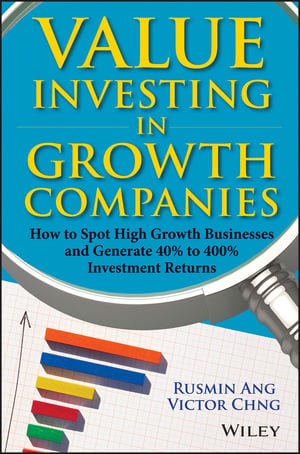There is nothing new in the book Value Investing in Growth Companies – How to spot high growth businesses and generate 40% to 400% investment returns by Rusmin Ang and Victor Ch’ng. That might sound negative, but really it isn’t. After all, as the old adage says – if it isn’t broken don’t fix it! Nowadays, investors and traders alike spoiled for options when it comes to making money – forex trading, palm oil growers scheme, commodity trading, property investment and the latest – binary options trading. Making money is one thing but it should also be sustainable. That’s why Rusmin & Victor have essentially distilled the methodologies of the top investing gurus of all time with proven track and sustainable performance – the likes of Benjamin Graham, Warren Buffett, Peter Lynch and Phillip Fisher.

If you are already a long term value investor, there are a lot of “AHA!” moments because the concepts just click in a concept known as The 4 Pieces Jigsaw Puzzle to Value-Growth Investing. As the authors put it – it is a quarter Science, a quarter Art, a quarter Quantitative and a quarter Qualitative. It is like when you’ve already achieved a certain degree of success in your business and career, and then you go to attend a session by an Action Coach on the topic of success and you realized – that you have been implementing all the strategies taught but never really give a thought on what you have been doing right all this while. It well written, reinforces on what you are doing right (or wrong) – you got the feel that the authors have “seriously pounded Singapore’s pavements in discovering the underdog companies before the crowds, then exiting profitably as mainstream investors move in and eventually pushing up the valuation”.
One core concept evident in the book is the concept of Value Growth as opposed to just Value. Here are the distinct differences and how they are “joined at the hip” as Warren Buffett once put it.



The content resonates with what have been said in Philip Cheng’s book – Taming the Money Sharks – on the part where one needs to exercise independent thinking and be emotionally stable. Else, how could we explain why there are so many losers in the stock market?
Also in synergy with what Prof Philip Cheng said about investing in your area of competence, in my previous interview with him – Warren Buffett also famously said this:
“You don’t have to be an expert on every company, or even many. You only have to be able to evaluate companies within your circle of competence. The size of that circle is not very important; knowing its boundaries, however, is vital.”


The other highlights and quotes of the book which I find interesting:
“Warren Buffett was once a trader who tried to master technical analysis, a technique he later found to be worthless, and that had cost him about eight years trying to master it”.
Scuttle butting by Philip Fisher – “Visit 5 companies in an industry, ask intelligent questions about the points of strength and weaknesses of the other 4 competitors and 9 out of 10, a surprisingly detailed and accurate picture of all five will emerge”
So in summary, if you are already doing well for years in your investment, this book may serve as a refresher. After all, you can’t teach old dogs new tricks, heh!
But if you are moving from the Dark Side to the Jedi world of Value-Growth Investing, then give this book a go. You could get it from bookstore but the easier way, of course, is to answer one question below.
TELL US HOW YOU ARE PRACTISING VALUE GROWTH INVESTING.
Post your answers below. Best 2 answers before 13 Oct will win this book, shipped to your doorstep FOC, courtesy of Wiley.
Winners this round – Teoh Giap Seng & Yang Kam Hau. Please use the CONTACT form above my webpage to give me your shipping address and phone number.